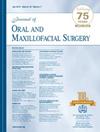Pretreatment Pain as a Prognostic Predictor in Oral Tongue Squamous Cell Carcinoma: The Mediating Role of Perineural Invasion
IF 2.3
3区 医学
Q2 DENTISTRY, ORAL SURGERY & MEDICINE
引用次数: 0
Abstract
Background
The potential effects of pretreatment pain on prognosis of tongue squamous cell carcinoma (TSCC) and the role that perineural invasion (PNI) plays in this process remains unclear.
Purpose
The purposes of this study are to estimate the prognostic value of pretreatment pain and identify whether PNI is a mediating factor in the relationship between pretreatment pain and prognosis in TSCC.
Study Design, Setting, Sample
This retrospective cohort study included TSCC patients who underwent first resections of primary lesions at the Beijing Stomatological Hospital of Capital Medical University between January 2009 and December 2019. Patients who had incomplete medical records and pathological data, received neoadjuvant radiotherapy and chemotherapy before surgery, and did not receive a TSCC diagnosis, were excluded.
Predictor Variable
The predictor variables are pretreatment pain and PNI. The visual analog scale (VAS) was used to assess pretreatment pain levels, and the PNI status was evaluated by pathological section.
Main Outcome Variable(s)
The main outcome variables were the 3-year disease-specific survival (DSS) and disease-free survival (DFS).
Covariates
Covariates included age, sex, smoking history, alcohol history, growth pattern, and T-stage.
Analyses
The χ2 test was used to describe the baseline data. Kaplan-Meier analysis was used to estimate the 3-year DSS and DFS. The Cox regression model was adapted for univariate and multivariate analysis. The association between VAS score and PNI was analyzed using logistic regression analysis and mediation analysis. P value less than .05 indicated statistical significance.
Results
The study included 307 subjects with a mean age of 52 (±12.1) years, and 164 (53.4%) were male. There were 65 (21.2%) with high VAS (>5) and 242 (78.8%) with low VAS (≤5). The DSS and DFS of high VAS were 64.6% (95% CI: 23.6 to 80.9%) and 52.3% (95% CI: 35.3 to 92.8%), of patients with PNI were 62.7% (95% CI: 19.6 to 64.5%) and 46.7% (95% CI: 25.9 to 66.9%), respectively. The group high VAS/with PNI had lower DSS and DFS than group high VAS/without PNI (55.3 and 40.4% vs 88.9 and 83.3%). The VAS and PNI were identified as independent factors associated with prognosis (P < .05). Mediation analysis revealed that the indirect effect of VAS on DFS was 0.071 (95% CI: 0.011 to 0.135, P = .024), while the total effect was 0.187 (95% CI: 0.074 to 0.296, P < .001), VAS score affected the DFS of TSCC through the mediating effect of PNI.
Conclusion and Relevance
Our findings confirmed that pretreatment pain is associated with worse outcomes in TSCC. Patients with TSCC and severe pretreatment pain are more likely to be diagnosed with PNI, which results in a worse prognosis.
预处理疼痛作为口腔舌鳞状细胞癌的预后预测因子:神经周围浸润的中介作用。
背景:预处理疼痛对舌鳞状细胞癌(TSCC)预后的潜在影响以及周围神经侵袭(PNI)在这一过程中所起的作用尚不清楚。目的:本研究的目的是评估预处理疼痛的预后价值,并确定PNI是否是TSCC中预处理疼痛与预后关系的中介因素。研究设计、环境、样本:本回顾性队列研究纳入2009年1月至2019年12月在首都医科大学附属北京口腔医院行原发性病变首次切除的TSCC患者。排除病历和病理资料不完整、术前接受新辅助放疗和化疗、未接受TSCC诊断的患者。预测变量:预测变量为预处理疼痛和PNI。采用视觉模拟评分法(VAS)评价预处理后疼痛程度,病理切片评价PNI状态。主要结局变量:主要结局变量为3年疾病特异性生存期(DSS)和无病生存期(DFS)。协变量:协变量包括年龄、性别、吸烟史、酒精史、生长模式和t分期。分析:采用χ2检验描述基线资料。采用Kaplan-Meier分析估计3年DSS和DFS。Cox回归模型适用于单因素和多因素分析。采用logistic回归分析和中介分析分析VAS评分与PNI的相关性。P值< 0.05为有统计学意义。结果:共纳入307例患者,平均年龄52(±12.1)岁,其中男性164例(53.4%)。其中,高VAS (bb0.5) 65例(21.2%),低VAS(≤5)242例(78.8%)。高VAS患者的DSS和DFS分别为64.6% (95% CI: 23.6 ~ 80.9%)和52.3% (95% CI: 35.3 ~ 92.8%), PNI患者的DSS和DFS分别为62.7% (95% CI: 19.6 ~ 64.5%)和46.7% (95% CI: 25.9 ~ 66.9%)。有PNI的高VAS/组DSS和DFS低于无PNI的高VAS/组(分别为55.3和40.4% vs 88.9和83.3%)。VAS和PNI被确定为与预后相关的独立因素(P结论和相关性:我们的研究结果证实,TSCC的预处理疼痛与较差的预后相关。TSCC和严重的预处理疼痛患者更容易被诊断为PNI,这导致预后较差。
本文章由计算机程序翻译,如有差异,请以英文原文为准。
求助全文
约1分钟内获得全文
求助全文
来源期刊

Journal of Oral and Maxillofacial Surgery
医学-牙科与口腔外科
CiteScore
4.00
自引率
5.30%
发文量
0
审稿时长
41 days
期刊介绍:
This monthly journal offers comprehensive coverage of new techniques, important developments and innovative ideas in oral and maxillofacial surgery. Practice-applicable articles help develop the methods used to handle dentoalveolar surgery, facial injuries and deformities, TMJ disorders, oral cancer, jaw reconstruction, anesthesia and analgesia. The journal also includes specifics on new instruments and diagnostic equipment and modern therapeutic drugs and devices. Journal of Oral and Maxillofacial Surgery is recommended for first or priority subscription by the Dental Section of the Medical Library Association.
 求助内容:
求助内容: 应助结果提醒方式:
应助结果提醒方式:


